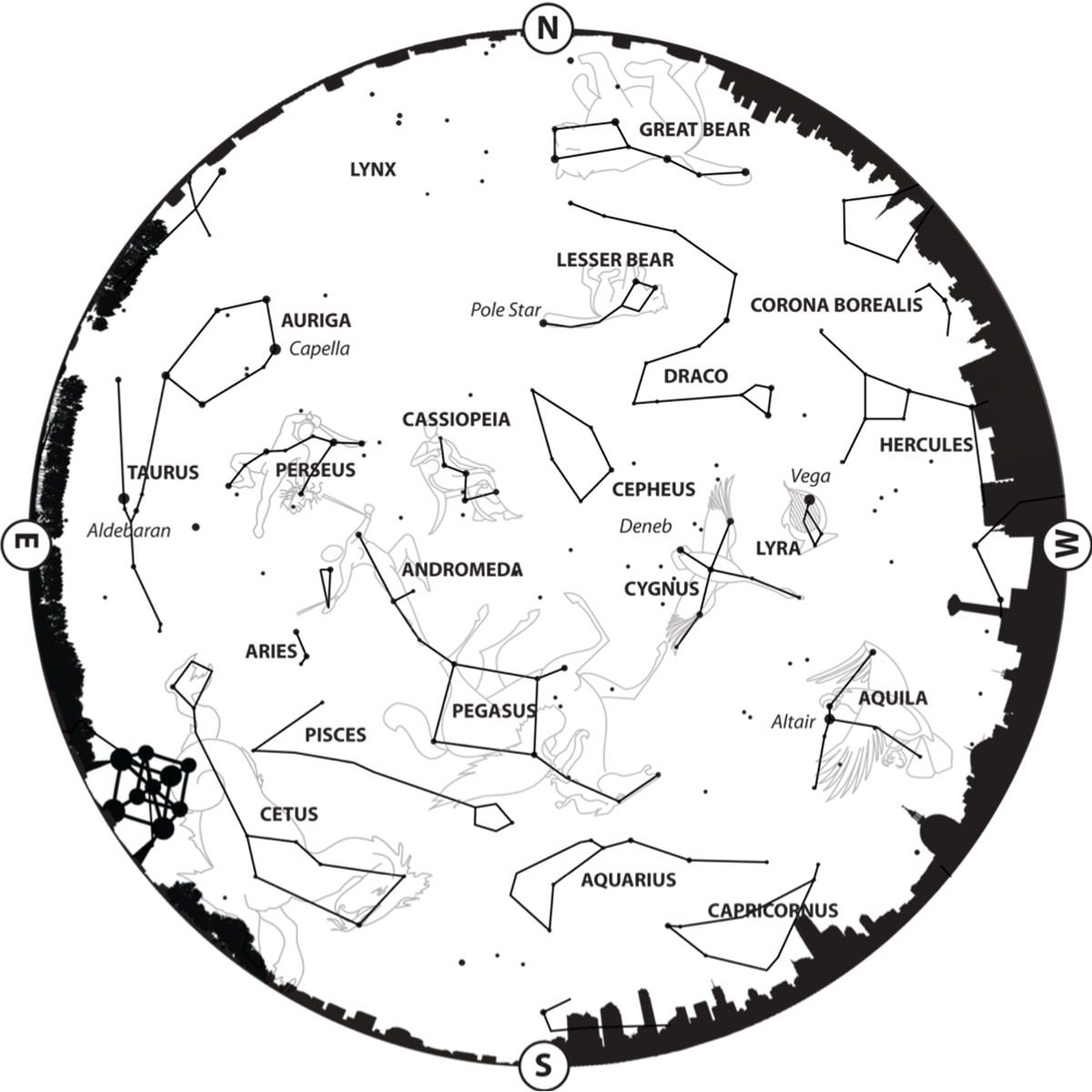Sky map

Belgian Skies
Autumn, beginning of the evening
Earlier civilizations had numerous legends depicted by constellations but we have to thank a Belgian, Eugene Delporte for defining the current 88 constellations. In the vicinity of large cities there is so much light pollution that only the brightest stars can be seen. The Great Bear looks like a frying pan. It's easy to find because it's so big and bright. Far from light pollution, it's possible to see up to 3000 stars with the naked eye.
In autumn, at nightfall, you can admire 3 very bright stars. Altair is one of them. It makes up the eye of the Aquila (the Eagle) constellation. Deneb is the tail of Cygnus (the Swan). It's also possible to distinguish the wings and the long neck. Between Cygnus and Hercules is Vega the third angle of a triangle. Vega is the brightest star of the Lyre: a small harp which Orpheus used to mislead Hades to free his beloved Eurydice from the Underworld.
Did you know that Vega will become our Pole Star? The Earth rotates and revolves but also has axial precession which causes a slow axial movement. The heavens thus tilt and Vega will be in the same position as the north star by the year 12000.
Some constellations are very well known, like the signs of the Zodiac. They form a band in the sky in the path of the sun, as seen from the Earth. At this time of year it's possible to recognise Sagittarius, some people maintain that the constellation looks like a teapot.
A large bright band seems to connect Sagittarius with Cygnus: this is the Milky Way. If we look at the sky from the edge of the Milky Way (where Earth is), we can either look at space which is pitch black and only scattered with a mere 3000 stars visible to the naked eye, or we can look at the centre of the Milky Way Galaxy. There are billions of stars, too far away to be distinguished as individual stars but whose combined light power causes this milky arc in the sky. In the vicinity of Sagittarius, the Milky Way seems to be more dense. That is the centre of the galaxy. This area is bursting with smog and star clusters. The best way to study the Milky Way is to go somewhere far from the pollution of cities.
East of Sagittarius is Capricorn, one of the oldest constellations. Babylonian writing tablets which are older than 3000 years already show it because at the time the sun was in Capricorn at the winter solstice. Another proof that Axial Precession exists. Capricorn is associated with the satyr, Pan, who jumped in the Nile to escape from the cruel and blood-thirsty Typhon. The lower half of Pan's body changed into a fish's tail. Another version will have it that Capricorn was the goat who suckled the Greek god Zeus. The horn that was broken off by the god later became the Cornucopia or the horn of plenty. Even further to the east we find more water constellations like Aquarius and Pisces. Next is the Ram.
At the end of autumn, when the triangle starts to disappear, Taurus appears. Its eye is formed by Aldebaran, a giant red star depicting the rage of the charging animal. Then Gemini appears, Castor and Pollux rise above the horizon. Pollux, the son of Zeus, therefore immortal, was inconsolable after the death of his brother. He pleaded with his father to bring him back to life whereupon Zeus transformed them into constellations where they live eternally.
Towards the North East and quite high in the sky, we find the vain Ethiopian Queen Cassiopeia. The constellation is a large lopsided 'w'. She was so vain that she told anyone and everyone who would listen that her daughter Andromeda was the most beautiful of all the princesses. This annoyed Poseidon, the god of the sea because he also had seven daughters, the Nereids, who were also exceptionally beautiful.
This mass of stars, called the Pleiades is actually a group made up of thousands of young stars. They came into being only a couple of tens of thousands years ago.
But back to our story: Poseidon, who was really annoyed, sent a huge sea monster, Cetus to terrorize the Ethiopian coast. Cassiopeia's subjects were terrified and decided to consult the oracle. The much loved princess was to be sacrificed to the sea monster. That is why she is represented chained to a rock swimming in the waves.
The rock is visible to the naked eye, as a spot: it is the furthest object from the Earth that can still be seen with the naked eye. It is one of the galaxies closest to us: Andromeda is approximately 3 million light years from us.
Fortunately for our princess, Perseus was on his way back from a battle where he had decapitated Gorgon Medusa. Her hair was replaced by hundreds of snakes. Such a horrible sight that whoever looked at it would turn to stone. Perseus possessed the means to deliver Andromeda with whom he fallen in love. He showed Medusa's head to Cetus who changed into a statue. Perseus placed his beloved on the winged mythological horse, Pegasus, and took her away to traverse the skies from one end to the other on Autumn nights.
The moon is easy to observe. It traverses the signs of the zodiac. It changes position every day. This proves that the moon is truly a satellite of the Earth and that is why it is sometimes visible during the day. Its shape is constantly in a phase of change. We speak of the phases of the moon. In reality, due to the moon's movement, we are sometimes in a more or less suitable position to see its illuminated side. There are 29 days between two new moons.

